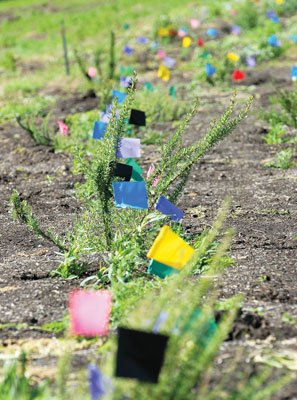Tick Creek doesn’t exactly sound like a patch of paradise, but
the water district is hoping to at least make it a bit less of a
breeding ground for invasive species.
Tick Creek doesn’t exactly sound like a patch of paradise, but the water district is hoping to at least make it a bit less of a breeding ground for invasive species.
The waterway, which runs from the Sargent Hills south of Gilroy to farmland east of U.S. 101, used to stand on a marshy area. Today, it’s more of a glorified ditch that faces challenges from invasive weeds such as poison hemlock.
Thanks to a $116,000 grant, the Santa Clara Valley Water District will get rid of many of the invasive plants and plant native ones as it seeks to increase riparian habitat, prevent soil erosion and improve water quality.
“We never will restore (the creek) to how it was during prehistoric times, but we are rehabilitating it,” said Carol Presley, senior environmental engineer for the water district.
The project, which started in December, is slated to be completed this fall, Presley said. Money for the improvements comes from the district’s Clean, Safe Creeks Grant Program, which is supported by Measure B, a parcel tax for creek safety and flood protection approved by Santa Clara Valley Water District voters in 2000. An independent expenditure committee approved the project grant in 2005.
Tick Creek originates in the Sargent Hills and then flows east across U.S. 101 through a culvert and traverses through the Carnadero Preserve to its ultimate discharge into Uvas-Carnadero Creek. From there, its waters ultimately discharge into the Pajaro River.
Presley hopes that within two to three years native species of plants along its creek bed will be able to “out-compete” the surrounding weeds. Rows of the native flora, including California aster, mugwort and western goldenrod, line the western edge of the creek bed after they were planted by water district staff and the San Jose Conservation Corps. The district is paying the conservation corps to assist with the project.
In time, the improvements will help the creek become more hospitable toward natural riparian habitat, including various invertebrates, insects and birds, Presley said. In addition, the project will help improve water quality, as vegetative roots and above ground biomass filter storm water and agricultural runoff, she said.
Intermixed with the native flora are plants that attract “beneficial insects” – or bugs that kill pests that prey upon the surrounding crops, Presley explained.
Row crops of certified organic and conventional fields stand next to the project area. The organic crops, in particular, rely upon natural pest management, which depends on insects that feed upon pest insects and their larvae, Presley said.
Cy Mann, the at-large water board director whose district includes South County, expressed enthusiasm about the project – particularly the beneficial insects portion.
“It allows these farmers to sustain themselves a little bit,” he said.
Mann hoped to see other organizations along with the county and its cities to apply for similar grants.
“I think it’s an awesome project,” he said. “I wish there was a lot more money to do stuff like this.”
The project stands on nearly 200 acres that the water district acquired in 2004 from the 474-acre Carnadero Preserve. The remaining portion of the reserve is an agricultural conservation easement owned by the Silicon Valley Land Conservancy. The water district uses its portion of the preserve to meet mitigation requirements because of habitat damage caused by removing sediment from creeks, repairing creek banks or removing non-native vegetation.
In the future, Presley hopes the water district will be able to conduct more projects within the preserve area, such as expanding existing wetlands.
“We do hope to come up with more projects and future grants,” Presley said.















